Overview
Navigating the process of advocating for Social Security Disability Insurance (SSDI) benefits can feel overwhelming. We understand that you may be facing numerous challenges, and it’s essential to approach this journey with thorough preparation and the right support. This article outlines a five-step process designed to help you effectively advocate for your benefits, emphasizing the importance of documentation and the potential advantages of engaging an advocate.
- Gathering your medical records and work history is crucial. These documents will serve as the foundation of your application, providing the necessary evidence to support your case.
- Next, it’s vital to complete the application accurately. Taking your time here can make a significant difference in your chances of success.
- Following up diligently is another important step. We know that the high denial rates for SSDI can be discouraging, but remember, you are not alone in this journey.
- Engaging trained non-legal advocates can greatly improve your chances of approval. Their expertise can guide you through the process, ensuring that you have the best possible support.
As you embark on this path, remember that we’re here to help. With the right preparation and assistance, you can navigate the complexities of SSDI advocacy with confidence. You deserve the support you need, and we encourage you to take these steps toward securing your benefits.
Introduction
Navigating the labyrinth of Social Security Disability Insurance (SSDI) can be daunting for many individuals facing disabilities. We understand that with approximately 70% of initial claims denied, the application process may feel overwhelming. However, understanding these intricacies is not just beneficial—it's essential.
This guide offers a clear pathway through the five critical steps to advocate for disability benefits, empowering you to tackle the challenges ahead.
How can you turn these overwhelming odds into a successful claim, ensuring that your rights and needs are met in a system that often feels impersonal and complex? Remember, you are not alone in this journey, and we’re here to help.
Understand Social Security Disability Insurance (SSDI)
Social Security Disability Insurance is a federal initiative designed to provide financial support to individuals who are unable to work due to qualifying disabilities. We understand that navigating this process can be challenging. To be eligible for disability benefits, applicants must have an adequate work history, which means accumulating enough work credits through past employment. This program is designed to advocate for disability social security to support those whose disabilities prevent them from engaging in substantial gainful activity.
Starting in 2025, changes to the eligibility criteria for disability benefits may affect many applicants. Currently, around 70% of initial disability benefit requests are denied, highlighting the importance of understanding the application process and eligibility requirements. If your request is denied, remember that you have the right to appeal the decision. Perseverance is essential on this journey.
Turnout is not a legal practice and does not provide legal advice; rather, it offers valuable support in navigating the disability benefits application process. Trained non-legal advocates assist clients in understanding their rights and options. This support is crucial, especially since the program not only provides financial aid but also significantly impacts the lives of countless disabled individuals. For example, in December 2023, over 8.7 million disabled beneficiaries received nearly $12.7 billion in benefits, underscoring the program's importance. Additionally, the Compassionate Allowances initiative has expedited the approval process for over 1.1 million individuals with severe disabilities, demonstrating the program's responsiveness to urgent needs.
Understanding the nuances of Social Security Disability Insurance—such as the definition of disability and the benefits available—is vital for anyone who wants to advocate for disability social security for themselves or others during the application process. You are not alone in this journey. For further details, we encourage you to visit the Social Security Administration's disability benefits page.
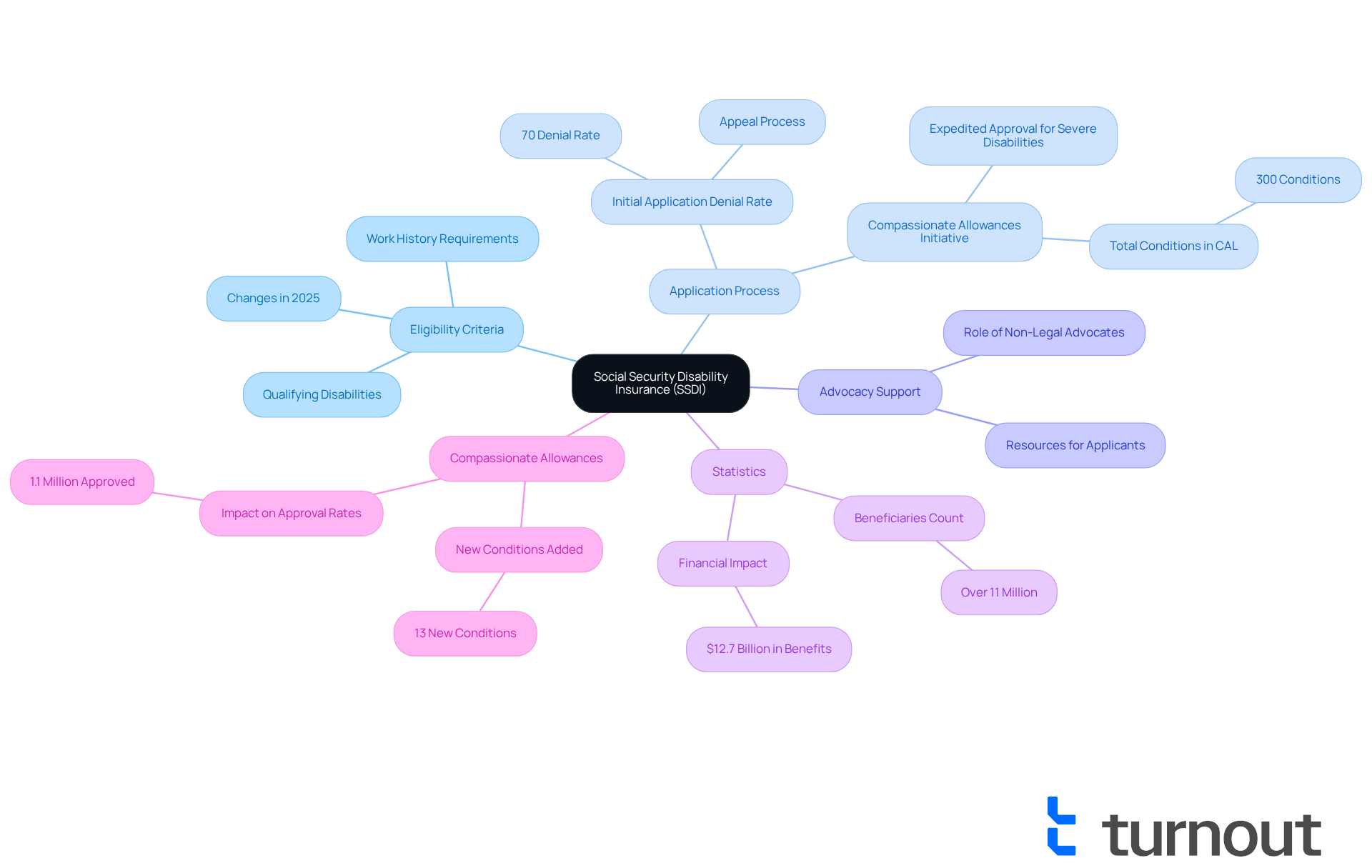
Apply for SSDI: Step-by-Step Process
Applying for SSDI can feel overwhelming, but you’re not alone in this journey. Here’s how to navigate the process with confidence:
-
Prepare Your Information: Start by gathering essential personal details. This includes your Social Security number, a comprehensive work history for the past 15 years, and thorough documentation of your medical condition, such as treatment history and current medications. We understand that this can be a lot to compile, but being organized will help you immensely.
-
Complete the Application: You can apply online at the SSA website, by phone, or in person at your local Social Security office. It’s important to complete the request thoroughly and precisely, using forms SSA-16 and SSA-3368. Remember, missing or incomplete information is a common cause of delays or rejections, so take your time to ensure everything is in order.
-
Submit Your Request: Once you’ve completed the application, send it along with any necessary documentation, including medical records and proof of work history. Prioritize submitting notes from specialists, as these carry more weight than general practitioner notes. This step is crucial in strengthening your case.
-
Follow Up: After submission, keep track of your application status. You can check your status online or by contacting the SSA. The initial evaluation period usually lasts 3 to 6 months, so staying informed is essential. It’s common to feel anxious during this waiting period, but staying proactive can ease some of that stress.
-
Respond to Requests: Be prepared to supply extra information or documentation if asked by the SSA during the evaluation. If your application is denied, remember that you have 60 days to appeal the decision, starting with a reconsideration. This is a crucial part of the process, and knowing your rights can empower you.
Turnout provides access to skilled non-legal advocates who can advocate for disability social security, supporting you during this journey and ensuring you have the assistance needed to manage the intricacies of SSD claims. It’s important to note that Turnout is not a law firm and does not provide legal advice; using our services does not establish an attorney-client relationship. Many candidates overlook the importance of retaining copies of submitted documents, which can obstruct the appeal process if needed. Successful applicants often highlight the importance of thorough preparation and prompt responses to SSA requests. For example, one applicant shared that having all medical documentation ready significantly improved their chances of approval. By understanding these steps and avoiding common pitfalls, you can navigate the disability benefits request journey more efficiently. Remember, we’re here to help you every step of the way.
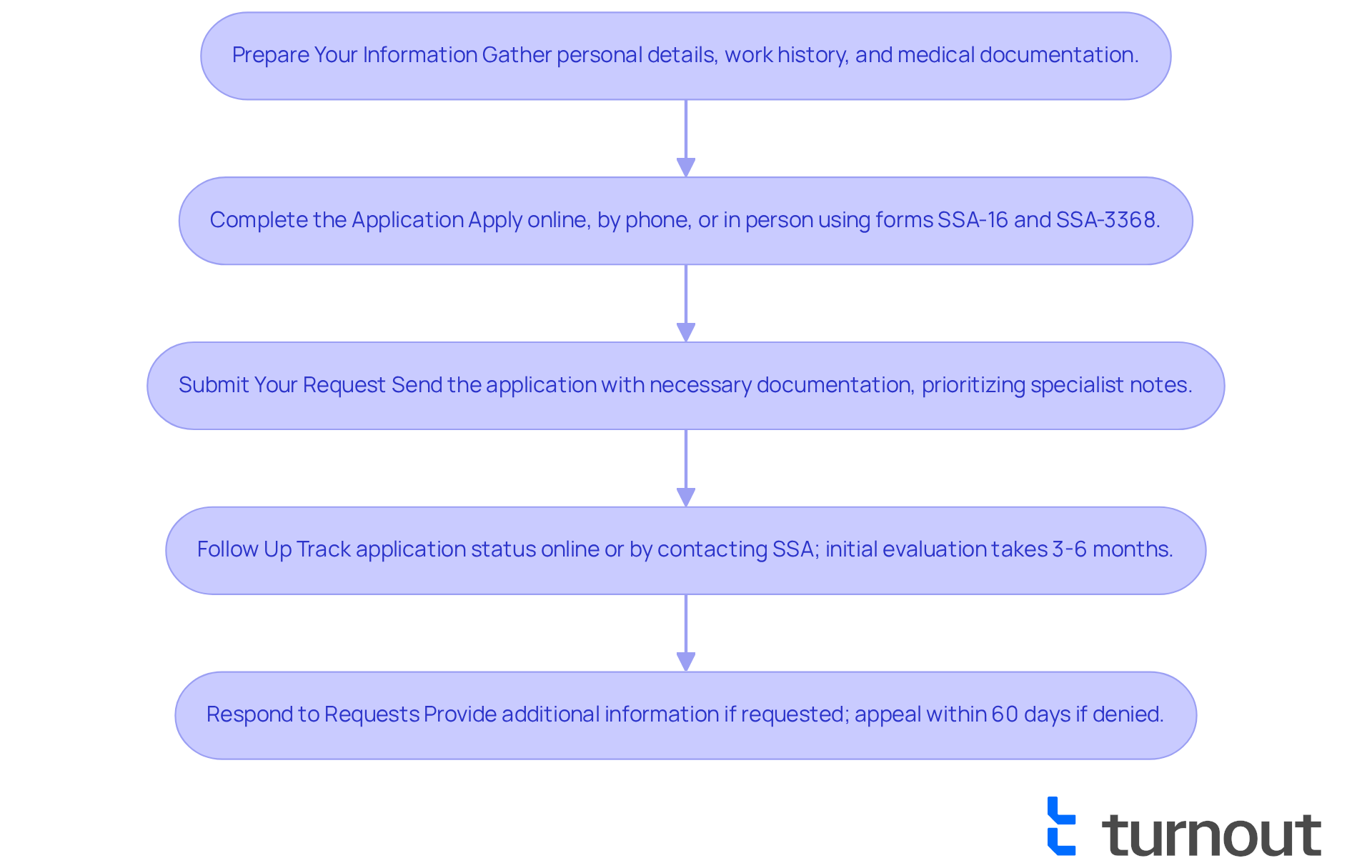
Gather Necessary Documentation and Confirm Eligibility
Collecting the necessary paperwork can feel overwhelming, but it's a crucial step in your journey to advocate for disability social security benefits. Here’s how you can navigate this process with confidence:
-
Medical Records: Start by obtaining detailed medical records from your healthcare providers. These documents should outline your condition and how it affects your ability to work. Strong medical evidence is essential, as it significantly increases your chances of securing benefits. Remember, following your doctor's treatment recommendations and attending scheduled appointments is vital for building this evidence.
-
Work History: Prepare a comprehensive work history that includes your dates of employment, job titles, and descriptions of your job duties. This information is important in establishing your eligibility based on work credits.
-
Personal Information: Collect personal identification documents, such as your birth certificate and Social Security card. These documents are necessary for verifying your identity and eligibility.
-
Financial Information: If applicable, gather information about your income and resources. This may be relevant for determining eligibility, especially for Supplemental Security Income (SSI).
-
Confirm Eligibility: We understand that navigating eligibility criteria can be daunting. Examine the requirements for Social Security Disability Insurance to effectively advocate for disability social security and ensure you meet them before submitting your request. In 2025, applicants generally need a total of 40 work credits, with at least 20 earned in the last 10 years before the onset of the disability. It’s common to feel discouraged, as around 78% of disability claims are first rejected. However, perseverance through the appeals system can serve to advocate for disability social security, which can lead to improved approval rates.
Turnout offers access to skilled non-legal supporters who can help you through this intricate process. They ensure you have the assistance needed to collect the essential documentation and verify your eligibility. For additional support, consider setting up a 'my Social Security' account to manage your disability and SSI benefits online. Also, consulting the Social Security benefits questionnaire can help you evaluate your eligibility. Remember, you are not alone in this journey, and we're here to help.
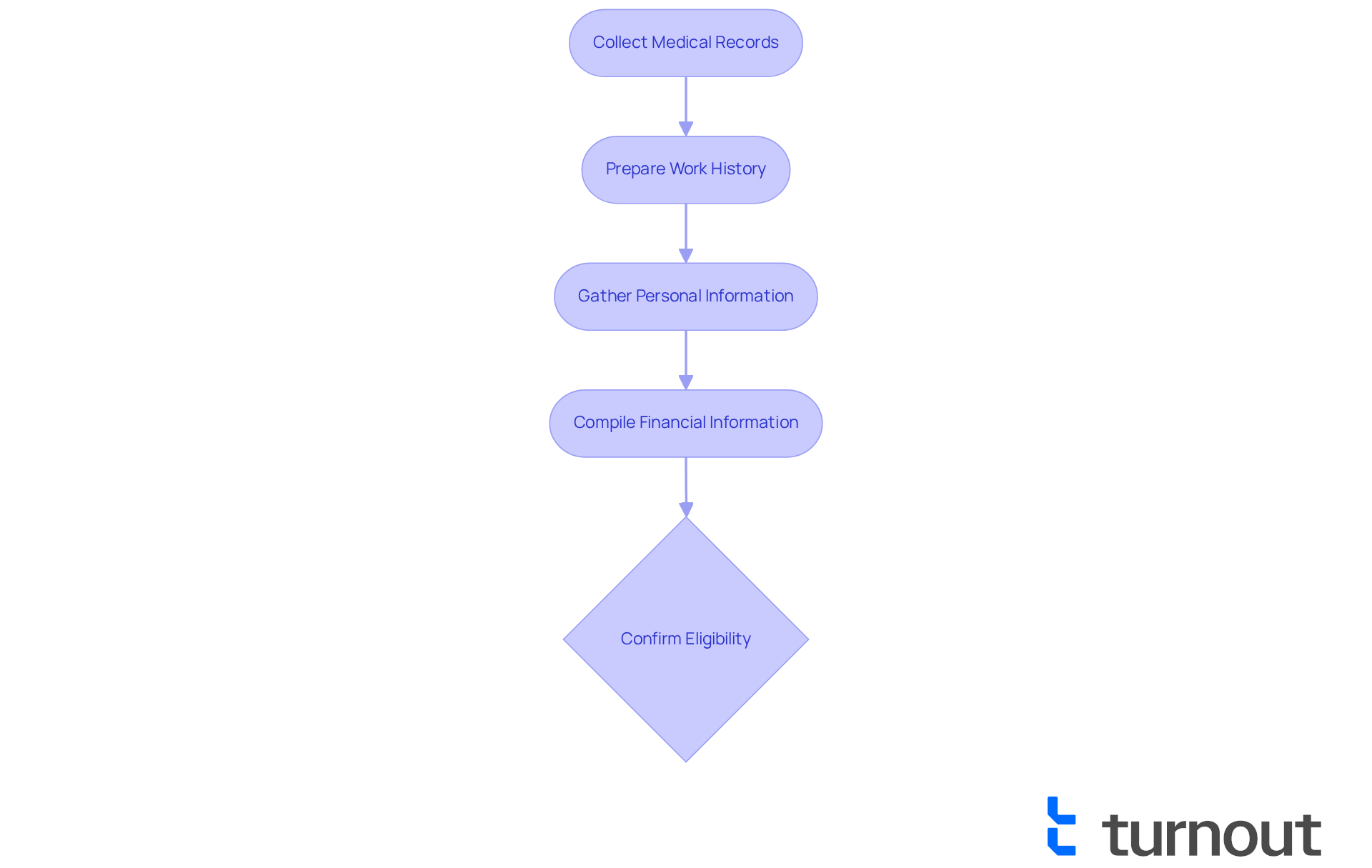
Engage an Advocate for Support and Guidance
Involving a representative can greatly improve your likelihood of achieving success in the disability benefits process. We understand that navigating this journey can be overwhelming, and having an advocate for disability social security by your side can truly make all the difference. Here’s how to find and collaborate effectively with an advocate:
- Research Supporters: Look for individuals who focus on SSDI requests. Referrals, online searches, and local disability organizations can help you identify qualified professionals who understand your needs.
- Schedule a Consultation: Many supporters provide free consultations. This is a remarkable chance to discuss your circumstances and discover how they can assist you in managing the intricacies of the submission process.
- Provide Necessary Information: Share your medical records, work history, and any other pertinent documentation with your representative. This information is essential for them to comprehend your situation and create a compelling submission tailored to your needs.
- Follow Their Direction: Your representative will provide personalized suggestions on finalizing your submission and may help in collecting extra documents to enhance your case. Remember, they are here to support you.
- Stay Informed: Keep an open dialogue with your representative during the procedure. Regular updates will ensure you are aware of any developments or requests from the Social Security Administration (SSA).
The significance of supporters who advocate for disability social security in the SSDI submission procedure cannot be overstated. Statistics indicate that applicants who seek assistance are three times more likely to obtain benefits compared to those who manage the system independently. Moreover, those who advocate for disability social security comprehend the subtleties of the submission process and can assist in steering clear of typical traps that lead to refusals. With the right support, you can turn a daunting task into a manageable and winnable endeavor. Remember, you are not alone in this journey; we are here to help you every step of the way.
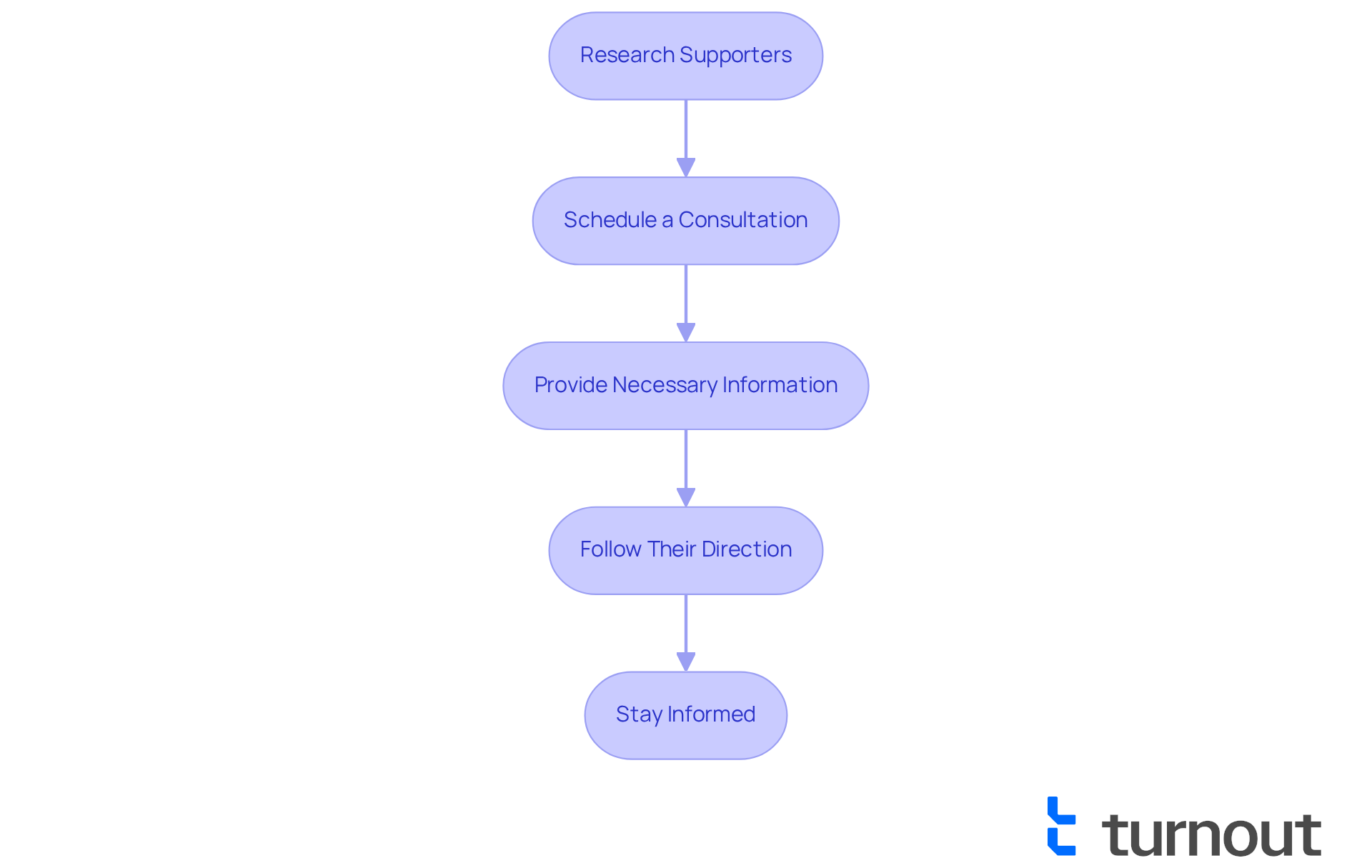
Troubleshoot Common Challenges in the SSDI Process
Navigating the disability benefits process can present various challenges, and we advocate for disability social security to support those who feel overwhelmed. Here are some common issues you might encounter, along with supportive solutions to help you through:
-
Incomplete Submissions: It's crucial to ensure that every part of your submission is filled out thoroughly. Did you know that about 65-70% of initial SSDI submissions are rejected? Often, this is due to missing information. Before you submit, take a moment to double-check for any missing details. This simple step can significantly improve your chances of approval.
-
Insufficient Medical Evidence: If your request is denied because of a lack of medical evidence, don’t lose hope. Gather additional documentation from your healthcare providers that clearly outlines your condition and limitations. The Social Security Administration requires detailed medical records spanning at least 12 months to demonstrate the ongoing severity of your disability. Remember, you are not alone in this; we advocate for disability social security and are here to help.
-
Long Processing Times: If your request is taking longer than you expected, it’s perfectly okay to reach out to the SSA to inquire about your status. The average wait time for initial decisions is typically between 3-6 months. If denied, the appeals process can extend to 12-24 months or even longer. Understanding your request's status can aid in managing your expectations and reduce anxiety.
-
Denials: If your request is denied, please don’t be discouraged. You have the right to appeal the decision. In fact, appeals processes often have better approval odds than initial applications, with administrative hearings showing success rates of 50-60%. Collaborate with your representative, who is a trained nonprofessional, to prepare a strong appeal that addresses the reasons for denial. Just a reminder, Turnout is not a law firm and does not provide legal representation, but we can still advocate for disability social security and assist you in navigating this process.
-
Communication Issues: Maintaining open lines of communication with the SSA and your representative is vital. Respond promptly to any requests for additional information to avoid delays. Proper support from Turnout's trained advocates can significantly enhance your chances of a favorable outcome when you advocate for disability social security claims. Remember, you are not alone in this journey, and we are here to support you every step of the way.
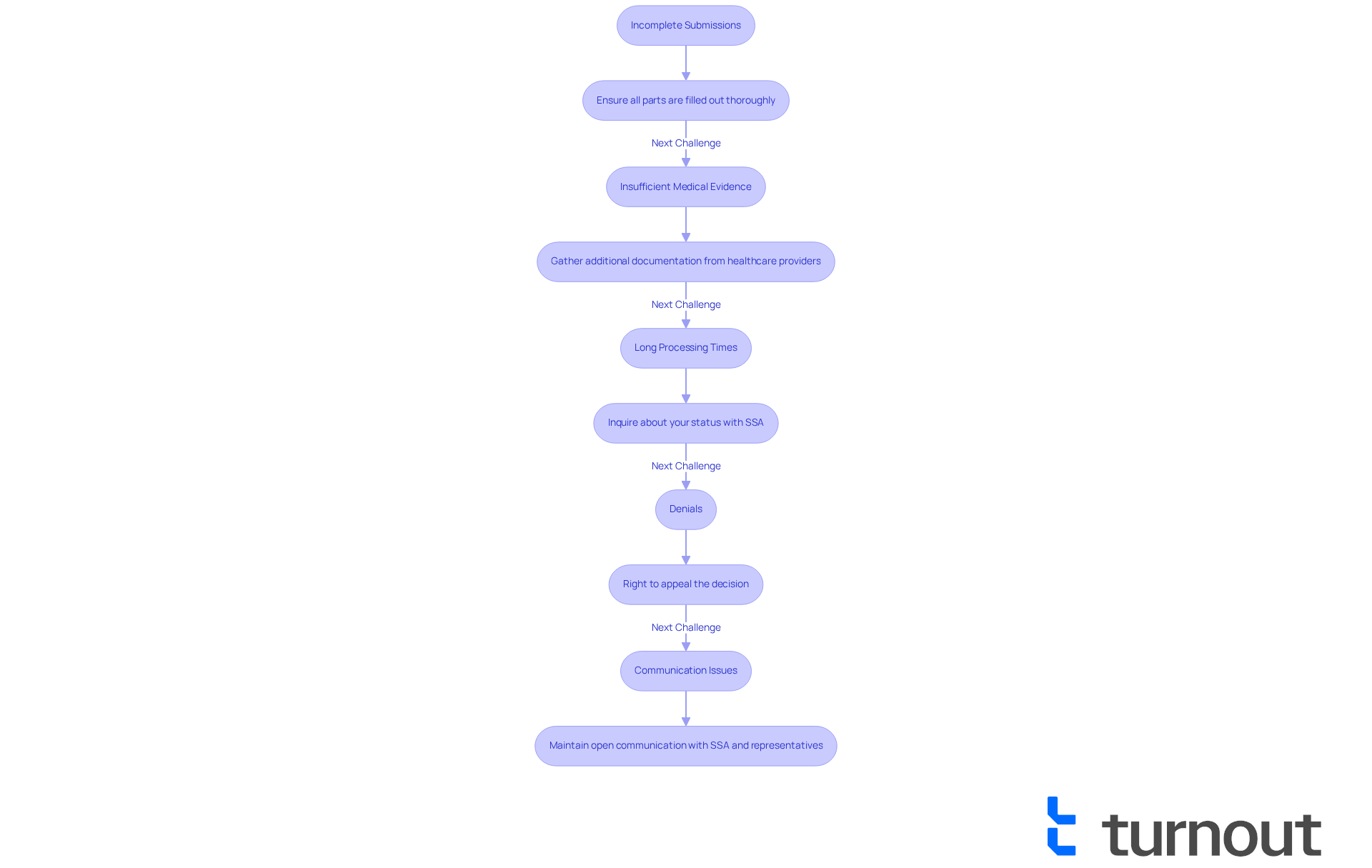
Conclusion
Successfully advocating for disability Social Security benefits can feel overwhelming. We understand that navigating the application process, eligibility criteria, and the need for thorough documentation can be daunting. However, this journey is essential, as it can lead to vital financial support for those unable to work due to disabilities. By following a structured approach and utilizing available resources, you can significantly enhance your chances of approval.
Key steps in this process include:
- Preparing comprehensive medical records
- Completing the application accurately
- Maintaining open communication with the Social Security Administration
Engaging with trained advocates can provide invaluable support, helping you navigate challenges such as incomplete submissions or insufficient medical evidence. Statistics show that those who seek assistance are far more likely to succeed, underscoring the importance of not facing this journey alone.
Ultimately, securing Social Security Disability Insurance is not just about overcoming bureaucratic hurdles; it’s about ensuring that individuals with disabilities receive the support they need to lead fulfilling lives. By taking proactive steps and leveraging available resources, you can advocate effectively for your rights and access the benefits that can make a significant difference in your life. Remember, you are not alone in this journey; we’re here to help.
Frequently Asked Questions
What is Social Security Disability Insurance (SSDI)?
SSDI is a federal program designed to provide financial support to individuals who are unable to work due to qualifying disabilities.
What are the eligibility requirements for SSDI?
To be eligible for SSDI, applicants must have an adequate work history, which involves accumulating enough work credits through past employment.
What is the current approval rate for SSDI applications?
Currently, around 70% of initial disability benefit requests are denied, making it essential to understand the application process and eligibility requirements.
What can I do if my SSDI application is denied?
If your application is denied, you have the right to appeal the decision, and perseverance is key in this journey.
What kind of support does Turnout provide for SSDI applicants?
Turnout offers valuable support in navigating the SSDI application process through trained non-legal advocates who assist clients in understanding their rights and options.
How many beneficiaries received SSDI benefits in December 2023?
In December 2023, over 8.7 million disabled beneficiaries received nearly $12.7 billion in benefits.
What is the Compassionate Allowances initiative?
The Compassionate Allowances initiative has expedited the approval process for over 1.1 million individuals with severe disabilities.
What information do I need to prepare before applying for SSDI?
You need to gather your Social Security number, a comprehensive work history for the past 15 years, and detailed documentation of your medical condition, including treatment history and current medications.
How can I apply for SSDI?
You can apply online at the SSA website, by phone, or in person at your local Social Security office using forms SSA-16 and SSA-3368.
What should I do after submitting my SSDI application?
After submission, keep track of your application status online or by contacting the SSA, as the initial evaluation period usually lasts 3 to 6 months.
What should I do if the SSA requests additional information after I apply?
Be prepared to supply any extra information or documentation if requested by the SSA during the evaluation process.
What is the importance of keeping copies of submitted documents?
Retaining copies of submitted documents is crucial as it can help avoid complications during the appeal process if needed.




